Mastering NumPy Random Matrix Generation: A Comprehensive Guide
NumPy random matrix generation is a powerful tool for creating arrays of random numbers in various shapes and distributions. This article will explore the intricacies of using NumPy’s random module to generate matrices, covering a wide range of functions and techniques. We’ll delve into the different types of random matrices, their applications, and provide numerous examples to illustrate their usage.
Introduction to NumPy Random Matrices
NumPy random matrices are multidimensional arrays filled with random numbers generated using various probability distributions. These matrices are essential in many fields, including statistics, machine learning, and scientific computing. The numpy.random module provides a suite of functions for generating random matrices with different properties and distributions.
Let’s start with a simple example of creating a random matrix using NumPy:
import numpy as np
# Create a 3x3 random matrix with values between 0 and 1
random_matrix = np.random.rand(3, 3)
print("Random matrix from numpyarray.com:")
print(random_matrix)
Output:

This code generates a 3×3 matrix filled with random numbers between 0 and 1, drawn from a uniform distribution.
Uniform Distribution Random Matrices
Uniform distribution is one of the most basic types of random number generation. NumPy provides several functions to create matrices with uniformly distributed random numbers.
np.random.rand()
The np.random.rand() function generates random numbers from a uniform distribution over [0, 1). Here’s an example:
import numpy as np
# Create a 4x4 random matrix with values between 0 and 1
uniform_matrix = np.random.rand(4, 4)
print("Uniform random matrix from numpyarray.com:")
print(uniform_matrix)
Output:
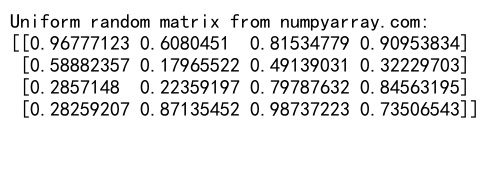
This code creates a 4×4 matrix with random values between 0 and 1.
np.random.uniform()
The np.random.uniform() function allows you to specify a range for the random numbers:
import numpy as np
# Create a 3x5 random matrix with values between -1 and 1
uniform_range_matrix = np.random.uniform(-1, 1, size=(3, 5))
print("Uniform random matrix with custom range from numpyarray.com:")
print(uniform_range_matrix)
Output:

This example generates a 3×5 matrix with random values between -1 and 1.
Normal Distribution Random Matrices
Normal (or Gaussian) distribution is another commonly used probability distribution for generating random matrices.
np.random.randn()
The np.random.randn() function generates random numbers from a standard normal distribution (mean=0, std=1):
import numpy as np
# Create a 3x3 random matrix from standard normal distribution
normal_matrix = np.random.randn(3, 3)
print("Standard normal random matrix from numpyarray.com:")
print(normal_matrix)
Output:

This code creates a 3×3 matrix with random values drawn from a standard normal distribution.
np.random.normal()
The np.random.normal() function allows you to specify the mean and standard deviation:
import numpy as np
# Create a 4x2 random matrix from normal distribution with mean=5 and std=2
custom_normal_matrix = np.random.normal(loc=5, scale=2, size=(4, 2))
print("Custom normal random matrix from numpyarray.com:")
print(custom_normal_matrix)
Output:
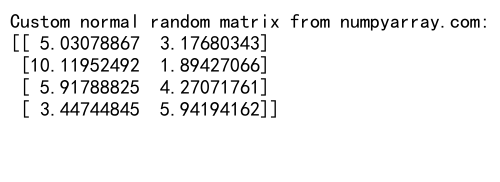
This example generates a 4×2 matrix with random values drawn from a normal distribution with mean 5 and standard deviation 2.
Integer Random Matrices
NumPy also provides functions to generate matrices with random integers.
np.random.randint()
The np.random.randint() function generates random integers within a specified range:
import numpy as np
# Create a 3x4 random integer matrix with values between 0 and 10
int_matrix = np.random.randint(0, 11, size=(3, 4))
print("Random integer matrix from numpyarray.com:")
print(int_matrix)
Output:
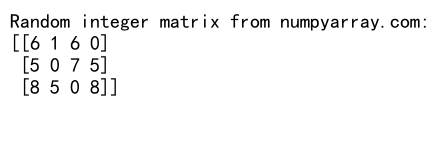
This code creates a 3×4 matrix with random integers between 0 and 10 (inclusive).
Seeding Random Number Generation
To ensure reproducibility of random matrices, you can set a seed for the random number generator:
import numpy as np
# Set a seed for reproducibility
np.random.seed(42)
# Create two identical random matrices
matrix1 = np.random.rand(2, 2)
matrix2 = np.random.rand(2, 2)
print("Random matrices with seed from numpyarray.com:")
print(matrix1)
print(matrix2)
Output:

This example demonstrates how setting a seed ensures that the same sequence of random numbers is generated each time the code is run.
Shuffling and Permutations
NumPy’s random module also provides functions for shuffling arrays and generating permutations.
np.random.shuffle()
The np.random.shuffle() function shuffles an array in-place:
import numpy as np
# Create a matrix and shuffle its rows
matrix = np.arange(9).reshape(3, 3)
np.random.shuffle(matrix)
print("Shuffled matrix from numpyarray.com:")
print(matrix)
Output:

This code creates a 3×3 matrix and shuffles its rows randomly.
np.random.permutation()
The np.random.permutation() function returns a randomly permuted copy of an array:
import numpy as np
# Create a permutation of a matrix
original_matrix = np.arange(12).reshape(3, 4)
permuted_matrix = np.random.permutation(original_matrix)
print("Permuted matrix from numpyarray.com:")
print(permuted_matrix)
Output:
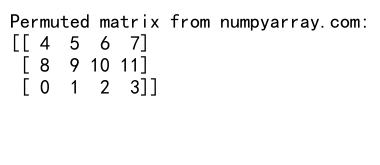
This example creates a 3×4 matrix and returns a randomly permuted copy of it.
Advanced Random Matrix Generation
NumPy offers more advanced functions for generating random matrices with specific properties or distributions.
Generating Sparse Random Matrices
You can create sparse random matrices using a combination of NumPy functions:
import numpy as np
# Create a sparse random matrix
size = (5, 5)
density = 0.2
sparse_matrix = np.random.choice([0, 1], size=size, p=[1-density, density])
print("Sparse random matrix from numpyarray.com:")
print(sparse_matrix)
Output:
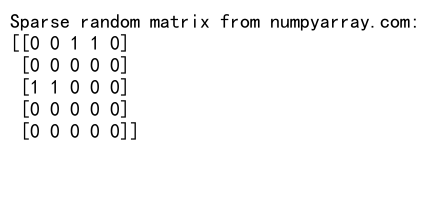
This code generates a 5×5 sparse matrix with approximately 20% non-zero elements.
Generating Symmetric Random Matrices
To create symmetric random matrices:
import numpy as np
# Create a symmetric random matrix
n = 4
random_matrix = np.random.rand(n, n)
symmetric_matrix = (random_matrix + random_matrix.T) / 2
print("Symmetric random matrix from numpyarray.com:")
print(symmetric_matrix)
Output:

This example creates a 4×4 symmetric random matrix.
Random Sampling from Arrays
NumPy’s random module also provides functions for random sampling from existing arrays.
np.random.choice()
The np.random.choice() function allows you to sample elements from an array with or without replacement:
import numpy as np
# Sample elements from an array to create a random matrix
elements = np.arange(10)
random_sample_matrix = np.random.choice(elements, size=(3, 4), replace=True)
print("Random sample matrix from numpyarray.com:")
print(random_sample_matrix)
Output:
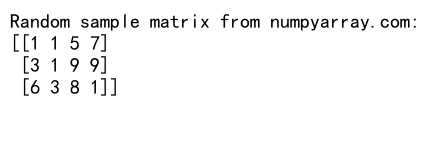
This code creates a 3×4 matrix by randomly sampling elements from the array [0, 1, 2, ..., 9] with replacement.
Generating Random Matrices with Custom Distributions
You can create random matrices with custom probability distributions using NumPy’s random module.
Using np.random.multinomial()
Here’s an example of generating a random matrix based on a multinomial distribution:
import numpy as np
# Generate a random matrix based on multinomial distribution
n_samples = 5
n_categories = 3
probabilities = [0.2, 0.3, 0.5]
multinomial_matrix = np.random.multinomial(n=10, pvals=probabilities, size=n_samples)
print("Multinomial random matrix from numpyarray.com:")
print(multinomial_matrix)
Output:

This code generates a 5×3 matrix where each row represents a random sample from a multinomial distribution with 10 trials and the specified probabilities.
Working with Random Matrices in Scientific Computing
Random matrices play a crucial role in various scientific computing applications. Let’s explore some common use cases.
Monte Carlo Simulations
Monte Carlo simulations often use random matrices to model complex systems:
import numpy as np
# Simple Monte Carlo simulation using random matrices
n_simulations = 1000
n_steps = 100
random_walks = np.random.choice([-1, 1], size=(n_simulations, n_steps))
final_positions = np.sum(random_walks, axis=1)
print("Monte Carlo simulation results from numpyarray.com:")
print(final_positions[:10]) # Print first 10 results
Output:

This example simulates 1000 random walks, each with 100 steps, using random matrices.
Generating Random Correlation Matrices
In finance and statistics, random correlation matrices are often used:
import numpy as np
# Generate a random correlation matrix
n = 5
A = np.random.rand(n, n)
B = np.dot(A, A.transpose())
D = np.diag(1 / np.sqrt(np.diag(B)))
correlation_matrix = np.dot(np.dot(D, B), D)
print("Random correlation matrix from numpyarray.com:")
print(correlation_matrix)
Output:

This code generates a random 5×5 correlation matrix.
Performance Considerations for Random Matrix Generation
When working with large random matrices, performance can become a concern. Here are some tips to improve performance:
- Use vectorized operations whenever possible.
- Consider using
np.random.Generatorfor better performance in newer NumPy versions. - For very large matrices, consider generating them in chunks or using memory-mapped arrays.
Here’s an example of using np.random.Generator:
import numpy as np
# Create a random number generator
rng = np.random.default_rng()
# Generate a large random matrix
large_matrix = rng.random((1000, 1000))
print("Large random matrix shape from numpyarray.com:", large_matrix.shape)
Output:

This code uses the newer Generator class to create a 1000×1000 random matrix efficiently.
Common Pitfalls and Best Practices
When working with NumPy random matrices, there are several common pitfalls to avoid and best practices to follow:
- Always set a seed for reproducibility in scientific computations.
- Be aware of the differences between various random number generation functions.
- Understand the underlying distributions and their parameters.
- Use appropriate data types to save memory and improve performance.
Here’s an example demonstrating some of these best practices:
import numpy as np
# Set a seed for reproducibility
np.random.seed(42)
# Generate a random matrix with appropriate data type
random_matrix = np.random.rand(5, 5).astype(np.float32)
print("Random matrix with best practices from numpyarray.com:")
print(random_matrix)
Output:

This code sets a seed, generates a random matrix, and uses a 32-bit float data type for efficiency.
Applications of Random Matrices
Random matrices have numerous applications across various fields. Let’s explore a few examples:
Machine Learning: Initializing Neural Network Weights
In deep learning, random matrices are often used to initialize neural network weights:
import numpy as np
# Initialize weights for a simple neural network layer
input_size = 10
output_size = 5
weights = np.random.randn(input_size, output_size) * np.sqrt(2 / input_size)
print("Neural network weights from numpyarray.com:")
print(weights)
Output:
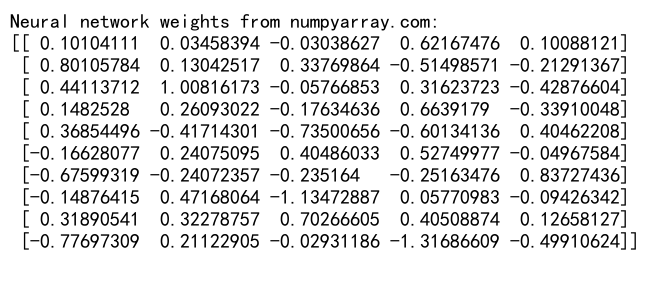
This example initializes weights for a neural network layer using the He initialization method.
Statistics: Bootstrapping
Bootstrapping is a statistical technique that often uses random sampling with replacement:
import numpy as np
# Perform bootstrapping on a dataset
data = np.random.randn(100)
n_bootstrap = 1000
bootstrap_means = np.zeros(n_bootstrap)
for i in range(n_bootstrap):
bootstrap_sample = np.random.choice(data, size=len(data), replace=True)
bootstrap_means[i] = np.mean(bootstrap_sample)
print("Bootstrap results from numpyarray.com:")
print(f"Original mean: {np.mean(data):.4f}")
print(f"Bootstrap mean: {np.mean(bootstrap_means):.4f}")
print(f"Bootstrap std: {np.std(bootstrap_means):.4f}")
Output:

This code demonstrates how to use random sampling to perform bootstrapping on a dataset.
Advanced Topics in NumPy Random Matrix Generation
As we delve deeper into NumPy random matrix generation, let’s explore some advanced topics and techniques.
Generating Random Matrices with Specific Eigenvalues
In some applications, you might need to generate random matrices with specific eigenvalues:
import numpy as np
# Generate a random matrix with specific eigenvalues
eigenvalues = [1, 2, 3, 4]
n = len(eigenvalues)
Q, _ = np.linalg.qr(np.random.randn(n, n))
matrix = Q @ np.diag(eigenvalues) @ Q.T
print("Random matrix with specific eigenvalues from numpyarray.com:")
print(matrix)
Output:

This code generates a random 4×4 matrix with the specified eigenvalues [1, 2, 3, 4].
Generating Random Matrices with Specific Correlation Structure
In some cases, you might want to generate random matrices with a specific correlation structure:
import numpy as np
# Generate random matrices with specific correlation structure
n = 4
correlation_matrix = np.array([
[1.0, 0.5, 0.3, 0.1],
[0.5, 1.0, 0.2, 0.4],
[0.3, 0.2, 1.0, 0.6],
[0.1, 0.4, 0.6, 1.0]
])
L = np.linalg.cholesky(correlation_matrix)
random_matrix = np.dot(L, np.random.randn(n, 1000))
print("Random matrix with specific correlation structure from numpyarray.com:")
print(np.corrcoef(random_matrix))
Output:

This example generates a random matrix with a specified correlation structure using Cholesky decomposition.
NumPy random matrix generation Conclusion
NumPy random matrix generation is a powerful tool with applications across various fields of science, engineering, and data analysis. This comprehensive guide has covered a wide range of topics, from basic random matrix generation to advanced techniques and applications.
We’ve explored uniform and normal distributions, integer random matrices, seeding for reproducibility, shuffling and permutations, sparse and symmetric matrices, custom distributions, and performance considerations. We’ve also looked at common pitfalls, best practices, and applications in machine learning and statistics.
By mastering these techniques, you’ll be well-equipped to handle a variety of tasks involving random matrices in your NumPy-based projects. Remember to always consider the specific requirements of your application, such as the desired distribution, matrix properties, and performance needs, when working with random matrices.